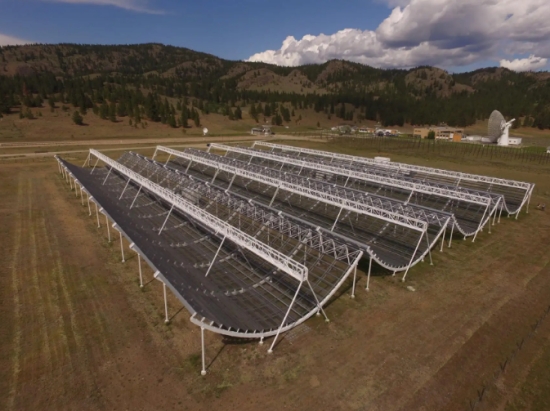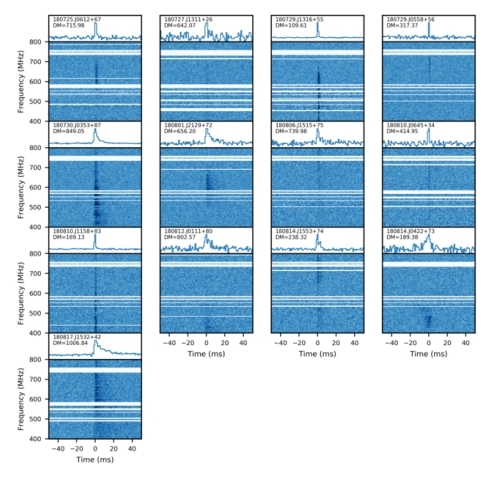Hard to believe that Fast Radio Bursts (FRBs) were only discovered in 2007, as it seems we’ve been puzzled by them for a lot longer. Thus far about 140 FRBs have been detected, but now we have news that the Canadian Hydrogen Intensity Mapping Experiment (CHIME) has pulled in a total of 535 new fast radio bursts in its first year of operation between 2018 and 2019. The catalog growing from this work was presented this week at the annual meeting of the American Astronomical Society.
“Before CHIME, there were less than 100 total discovered FRBs; now, after one year of observation, we’ve discovered hundreds more,” says CHIME member Kaitlyn Shin, a graduate student in MIT’s Department of Physics. “With all these sources, we can really start getting a picture of what FRBs look like as a whole, what astrophysics might be driving these events, and how they can be used to study the universe going forward.”

Image: The large radio telescope CHIME, pictured here, has detected more than 500 mysterious fast radio bursts in its first year of operation, MIT researchers report. Credit: Courtesy of CHIME.
CHIME involves four cylindrical radio antennas that MIT describes as “roughly the size and shape of snowboarding half-pipes” located in British Columbia, and operated by the National Research Council of Canada. A correlator instrument — a digital signaling processor — digs through data from the stationary array at a rate of 7 terabits per second, allowing it to detect FRBs at a thousand times the pace of conventional radio telescopes.
We learn, for one thing, that FRBs are common, and frequent. Kiyoshi Masui (MIT) presented the catalog to conference goers on Wednesday the 9th:
“That’s kind of the beautiful thing about this field — FRBs are really hard to see, but they’re not uncommon. If your eyes could see radio flashes the way you can see camera flashes, you would see them all the time if you just looked up.”
It becomes clear from these data that the FRBs detected in the first year were evenly distributed in space, appearing in all parts of the sky. Their rate is thus far calculated to be 800 per day across the entire sky, a figure that is considered the most precise estimate of the phenomena’s occurrence that has yet been presented. Most bursts appear to have originated within distant galaxies, meaning they were highly energetic.
Two categories of FRB also emerge: Those that repeat and those that do not. 18 of the CHIME sources do repeat, with the rest one-time events. Among the repeating signals, each burst lasts slightly longer and emits more focused radio frequencies then bursts from single, non-repeating FRBs. We seem to be looking at two different kinds of astrophysical sources, or at least separate mechanisms, and it will be a goal of future data collection to clarify the differences between the two.

Image: The first 13 FRBs found by CHIME/FRB (from CHIME/FRB Collaboration, 2019, Nature, 566, 230). In this plot, the effects of dispersion have been removed from each source. Credit: CHIME.
While researchers work to learn what could cause such bright, fast signals, it’s fascinating to compare the FRB work with the use of supernovae as ‘standard candles.’ Evidence for the accelerating expansion of the universe was found by such measurements. Can FRBs be used as standard candles for other kinds of detections? Each FRB yields information about its propagation in terms of how gas and matter are distributed along the way to us. Kaitlyn Shin refers to the possibility of using them as “cosmological probes,” a potential enhanced by this new and growing catalog.



What I find remarkable is the duration of the bursts. That is correlated to the size of the source. It would appear that the diameter of many of these sources is no more than a few thousand km, and possibly smaller. For the strength of the bursts, the energy density would have to be impressive.
Another good example where wide field views can collect data that would be serendipitous with narrow views. IIRC, previously we had possible detection of single events, then later repeating events. CHIME now detects lots of events and both types are detected. A catalog of events should help define the mechanisms that generated the FRBs.
No doubt the SETI scientists would like such an approach especially if interstellar communication is best achieved with targeted bursts.
It makes one wonder what other discoveries can be made when instruments with different bandwidth sensitivities can be designed to look at larger areas of the sky.
The intensity/energy density at their sources may be adequate to permit the carriage of substantial volumes of data on FRBs. And advanced configuration techniques may do the equivalent of weaving thread into a cloth and then rolling it compactly. Those with the greatest expertise in deciphering messages – the NSA – should work on FRBs if they have not already done so.
Robin! I’m wondering if they are isotropic (candle-like) or jets/directed? If jets, and we are detecting them at such a high rate, that implies a lot of comms traffic, right?
Mystery upon mystery although everything may turn out tic tacs: ET’s breath mint joke on us!
I agree Alex, re commonality: if common and artificial – they are here (reference tic tacs!) if common and natural – just hope that that 2 x 10^31 joule gun isn’t pointed at me! (millisec FRB power = 3 days solar output)